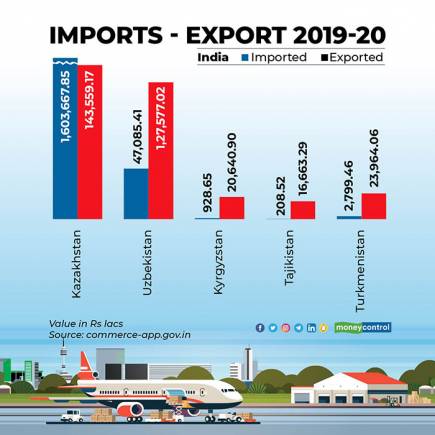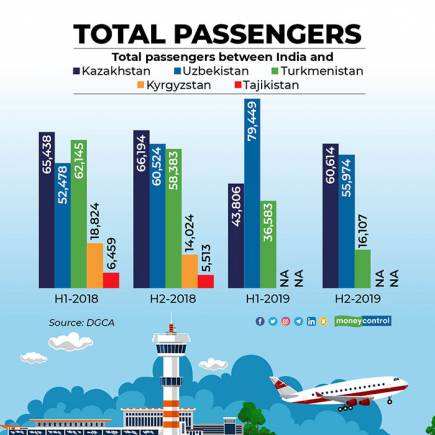How a prolonged Afghan crisis could derail India-Central Asia connectivity
09:53AM Fri 27 Aug, 2021

-
With the Taliban having an air arm and in possession of surface-to-air missiles, airlines are likely to give Afghanistan a wide berth, increasing travel time to Central Asia
 The trade and cultural ties between India and some of these countries date back centuries.
What happened from 1996 to 2001?
Kabul fell in 1996 and the Taliban was in control. While Uzbekistan Airways had flights to India back then, Air Astana launched services to New Delhi in 2004. Turkmenistan Airlines started its Indian operations around 2000. Airlines from Kyrgyzstan and Tajikistan joined the party much later.
Airlines continued to overfly Afghanistan during the previous stint of the Taliban but times are different now. The renewed capability of the group, its air arm, and its weapons cache are some of the things that will dictate how airlines respond.
The trade and cultural ties between India and some of these countries date back centuries.
What happened from 1996 to 2001?
Kabul fell in 1996 and the Taliban was in control. While Uzbekistan Airways had flights to India back then, Air Astana launched services to New Delhi in 2004. Turkmenistan Airlines started its Indian operations around 2000. Airlines from Kyrgyzstan and Tajikistan joined the party much later.
Airlines continued to overfly Afghanistan during the previous stint of the Taliban but times are different now. The renewed capability of the group, its air arm, and its weapons cache are some of the things that will dictate how airlines respond.
 However, connectivity will face serious trouble if Afghanistan has to be avoided completely. Airlines scaled down operations to India when Pakistan’s airspace was closed. However, back then, the Afghan airspace was open. When Afghanistan’s airspace is not available, it forces airlines from the Central Asian republics to take to a longer route.
The window of opportunity
United Airlines has been operating flights to India with a routing that is remarkably different from Air India. The air route runs from Tajikistan’s airspace to Pakistan, overflying Afghanistan for a very short duration.
A recent NOTAM (notice to airmen) from the United States allows the use of air route P500-G500 for transiting overflights. This air route is from Tajikistan to Pakistan, flying for a very short period over the Wakhan Corridor in Afghanistan, which separates Tajikistan from Pakistan.
The new route saves two hours of flying time, based on data on the aircraft-tracking website Flightradar24.
However, connectivity will face serious trouble if Afghanistan has to be avoided completely. Airlines scaled down operations to India when Pakistan’s airspace was closed. However, back then, the Afghan airspace was open. When Afghanistan’s airspace is not available, it forces airlines from the Central Asian republics to take to a longer route.
The window of opportunity
United Airlines has been operating flights to India with a routing that is remarkably different from Air India. The air route runs from Tajikistan’s airspace to Pakistan, overflying Afghanistan for a very short duration.
A recent NOTAM (notice to airmen) from the United States allows the use of air route P500-G500 for transiting overflights. This air route is from Tajikistan to Pakistan, flying for a very short period over the Wakhan Corridor in Afghanistan, which separates Tajikistan from Pakistan.
The new route saves two hours of flying time, based on data on the aircraft-tracking website Flightradar24.
Air India is said to have explored this route to operate its flights. If airlines, post-risk assessment, decide to use this route, it would become a very popular and busy route. However, the risk assessment will not be limited to just shoulder-fired missiles from the Taliban but the capability of its air arm, as well.
One can only hope that on the other side of the pandemic, when travel resumes, things in Afghanistan settle down and airlines are able to maintain their pre-pandemic connectivity.
(Source: Money control)











